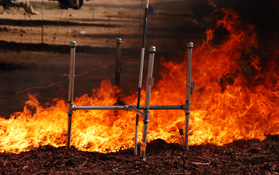Landscape mulch may pose fire hazard
-
July 20, 2011
-
-
CONTACT: Pam Kan-Rice
-
(530) 754-3912
-
pskanrice@ucdavis.edu
-
-
N / A
-
 Rubber mulch produced the highest flames of mulches tested.
Rubber mulch produced the highest flames of mulches tested.Landscape mulch provides many benefits to a garden, but people living in wildfire-prone areas should be careful about the type of mulch they use around their homes. Embers landing on combustible mulch may set the mulch on fire and lead the fire to the house, warns a University of California Cooperative Extension advisor.
"We know that the zone within about 5 feet of the home is very important to home survival during a wildfire," said Steve Quarles, UC Cooperative Extension advisor who studies wood performance and durability. "We call this near-home zone the ‘noncombustible or low combustible zone.'"
He added, "We know that certain woody vegetation, such as juniper, shouldn't be placed near the home. Information from this study will help individuals select mulch products for use in this critical area in order to further reduce the vulnerability of their home to wildfires."
There are two categories of mulches: organic and inorganic. Organic mulches are usually plant materials such as pine needles, wheat straw, pine bark nuggets of various sizes, shredded western red cedar and redwood bark, wood chips from recycled pallets or wildfire fuel reduction projects and cocoa shells but also include ground and shredded rubber. Inorganic mulches are non-plant materials such as rock, gravel and brick chips.
Organic and inorganic mulches vary considerably in terms of size, shape, texture and parent material, all of which can influence their combustibility.
Quarles and University of Nevada Cooperative Extension natural resource specialist Ed Smith, in collaboration with the Carson City Fire Department, Nevada Tahoe Conservation District and the Natural Resource Conservation Service, tested the combustibility of eight types of mulches. After exposing the mulch to summer weather for 12 weeks, the scientists ignited each type, then evaluated the flame height, rate of fire spread and temperature above the mulch bed.
With the exception of the composted wood chips, all of the mulch treatments readily began flaming. Composted wood chips smoldered, but produced very little flame. Fire spread the fastest in shredded rubber, pine needles and shredded western red cedar.
Quarles recommends not using any organic mulch within 5 feet of a house located in wildfire prone areas. Instead, place non-combustibles such as rock, pavers, brick chips or well-irrigated, low-combustible plants such as lawn or flowers closest to the house. The more combustible mulches should be used more than 30 feet from the home.
Quarles and Smith have published a manual comparing the relative combustibility of the eight mulch treatments and their recommendations for use. To download a free copy of “The Combustibility of Landscape Mulches,” please visit http://firecenter.berkeley.edu/node/65.
